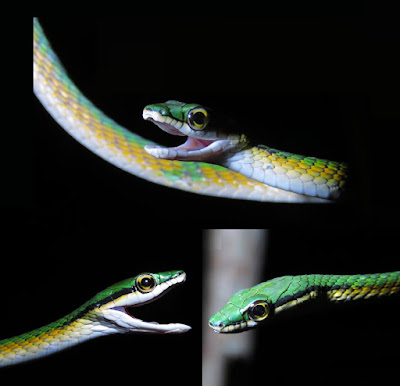Abstract
We describe a new species of Leptophis (parrot snake) from the Cerrado ecoregion of Brazil. The new species, L. mystacinus sp. nov., differs from all other congeners in the following unique character combination: two Spectrum Green (129) to Light Parrot Green (133) dorsolateral stripes separated by a Buff (5) vertebral stripe, usually continuous onto the tail; loreal scale absent; postocular stripe Jet Black (300), wide and long (up 11 scales long onto nuchal region); maxillary teeth 21–25; ventrals 158–173; subcaudals 141–164; black spots on head absent; supracephalic plates of head not edged with black pigment; adult color pattern lacking dark oblique bands; keels absent on first dorsal scale rows; hemipenis unilobed, noncapitate, with undivided sulcus spermaticus, and first row of hemipenial body with four spines. Phylogenetic analysis of 16S mtDNA sequences indicate the new species is the sister taxon of L. dibernardoi, a species occurring in the neighboring Caatinga ecoregion.
 |
| Holotype of Leptophis mystacinus (ZUFMS-REP004702). (A) Right and left (B) lateral views of head of the holotype in life, from Pium, state of Tocantins, Brazil. Photos by L. A. Silva. |
Leptophis mystacinus sp. nov.
Diagnosis: Leptophis mystacinus sp. nov. can be distinguished from all currently recognized congeners by a unique combination of the following characters: two Spectrum Green (129) to Light Parrot Green (133) (Sky Blue (167) in preservative) dorsolateral stripes (2–4 scales wide, at least anteriorly) separated by a Buff (5) (Light Sky Blue (191) in preservative) vertebral stripe (1–1.5 scales wide), usually continuous onto the tail (occasionally indistinct on posterior third of tail); dorsal scale rows below the lateral stripes usually Dark Spectrum Yellow (78) (Sky Blue (167) in preservative); loreal scale absent; postocular stripe Jet Black (300), wide (extending to lower postocular, lower half to two-thirds of anterior temporal, one-third to lower half of lower posterior temporal, upper edges of last three supralabials) and long (up 11 scales long onto nuchal region); anterior to orbit, stripe reduced to black margin of supralabials 1–3 or 1–4, posterior lower edge and anterior upper edge of nasal and upper edge of rostral scale. Ventral surfaces of head, trunk, and tail white to Smoky White (261). Maxillary teeth 21–25; ventrals 158–166 in males, 158–173 in females; subcaudals 153–164 in males, 141–158 in females.
Etymology: The specific name is derived from the Greek mystax (transliteration of μύσταξ), meaning ‘upper lip’ or ‘mustache’, and the Latin suffix -inus, denoting ‘likeness’ or ‘belonging to’. The black pigmentation covering the rostral scale of Leptophis mystacinus is distinct in most individuals, giving the appearance of a mustache.
Nelson R. Albuquerque, Roullien H. Martins, Priscila S. Carvalho, Donald B. Shepard and Diego J. Santana. 2025. A New Species of Parrot Snake, Leptophis (Serpentes: Colubridae) from the Brazilian Cerrado. PeerJ. 13:e18528. DOI: doi.org/10.7717/peerj.18528
x.com/DiegoJSantana/status/1885068476785602850


